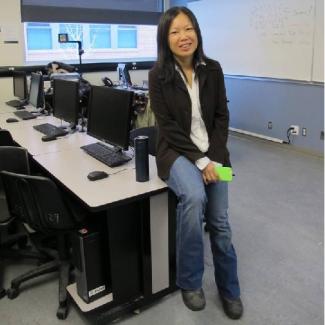Problem solving is a core life skill, tied to many skills found in computational thinking, including literacy and abstraction.
Dr. Bowen Hui, a Language Sciences member and Associate Professor of Teaching at UBCO Computer Science, discusses how computational thinking is linked to language learning, and why it’s important to teach ‘little scientists’ these skills.
What is computational thinking? How is it linked to language?

Computational thinking is a thought process that uses certain skills to solve problems that have relevance in programming and computer science in general. These skills include literacy, numeracy, algorithmic thinking, evaluation, and abstraction.
Our research further identifies a developmental perspective of computational thinking because individuals develop these skills in different ways, which enable them to solve different types of problems depending on what stage they are at. As one advances through these stages and begins to tackle problems that require programming, the problems become more mathematical, symbolic, and abstract.
While computational thinking is not directly related to language itself, many of the skills as well as the goal of programming are related to language learning.
This is because a programming language is a structured language that has syntactic and semantic properties, similar to a natural language.
Why is it important to teach children these skills?
Learning computational thinking skills is crucial for children because many of these skills are relevant to solving general problems. For example, being skillful at decomposition enables a child to take a complex problem, break it down into smaller sub-problems, solve each sub-problem in a manageable way, and piece those solutions back together to solve the original problem.
Traditionally, computer science education typically started with programming, where introductory classes teach students a new programming language while solving simple programming problems. Since most formal computer science education starts at the university level, the assumption is that adult learners in these classes would have a good handle on computational thinking skills. For these learners, this means that the task of acquiring a new programming language and refining their existing computational thinking skills are carried out simultaneously.
However, as programming literacy becomes more important in our society, researchers and educators worldwide are now advocating for computational thinking and computer science education to become an integral part of the K-12 public school curriculum.
What are some techniques for teaching computational skills to children who can’t read and write?
In our research, we outlined the computational thinking skills that are relevant to specific age groups. For preschool children, teaching them computational thinking skills typically means helping them improve their numeracy skills (moving from counting one, two, many, to counting one to five or higher), literacy skills (reading, learning the basic alphabet, spelling their own name), and algorithmic thinking and evaluation skills (applying the trial and error strategy to determine the outcome success).
It gets really interesting with pre-literate school children, or those aged about five to seven years old. They are typically already learning a lot about literacy and numeracy in their school curriculum.
However, children at this age are so curious about everything and they really act like little scientists carrying out experiments in their own ways. This behavior serves as the perfect opportunity to foster their reasoning and problem-solving skills.
While we can be enthusiastic and supportive of their endeavors, we need to also be aware that most of them are not yet ready to handle complex problems or problems involving symbolic. So teaching them these skills mostly means giving them exposure to observe how others exercise computational thinking skills and giving them a lot of opportunities to explore how they can apply these skills under guidance.
